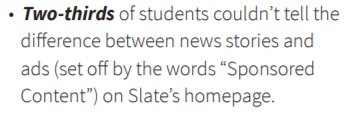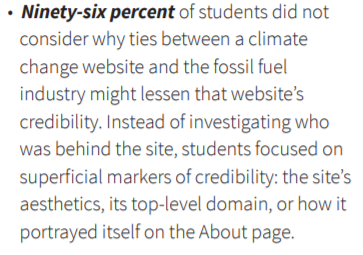News Literacy: Not Just Another Education Buzzword, a guest post by Jamie Gregory

Remember that assignment in junior high to watch the nightly news and keep a journal of what you watched? That was pretty simple for me; all I had to do was turn on CNN and get my notebook.
But that was the 90s. Now as an educator, I wonder if my teachers ever encountered any student pushback about “fake news” or had trouble with students using less-than-credible news sources.
ADVERTISEMENT
ADVERTISEMENT
Currently, we have movements across our country to create media literacy legislation mandating instruction. But beware: don’t allow news literacy (a subset of information and media literacy) to become merely a buzzword in education. It indicates our young people’s need to learn how to navigate the rapidly-evolving information landscape. And within that, yes, #FactsMatter.
What’s at stake? Consider real-life consequences of mis/disinformation:
- The Pizzagate conspiracy theory caused an armed man to open fire inside the Comet Pizza restaurant. Thankfully no one was injured.
- How about determining whether or not an event actually happened? Alex Jones used his InfoWars platform to claim the Sandy Hook school shooting was a hoax and has lost in court. But imagine the emotional impact of his “theories” on a family who has lost a child to murder.
- A 4 year-old died of the flu after the mother sought medical advice from an anti-vaccination group on Facebook
- In the fall of 2020, wildfires ravaged areas of Oregon. Rumors and misinformation caused funds and efforts to be diverted from the actual cause. The FBI and other local officials released statements debunking the false rumors (and utilized social media).

Teachers often feel like they don’t have time to incorporate information, media, and news literacy, mostly due to testing and the need to cover content. Others may feel news literacy is too political or polarizing. However, if teachers do collaborate with school librarians on these skills, news literacy education cannot fall into the traps of “drill and kill” instruction, or library “drive-by” instruction (e.g. practice involving only pre-selected websites; visiting the library one time a year for brief instruction). It won’t work.
How to avoid those pitfalls? Embed and integrate news literacy into what you’re already doing. Design activities requiring students to engage in critical thinking using real-world examples. Take the time to find out your students’ current habits. Meet them where they’re at. For example, they aren’t going to drop Google and solely use databases. They aren’t going to forego news apps and YouTube news channels to start watching news on television or purchase the print edition like “the old days.” And that’s okay. That’s the evolving information landscape.
Below are some ideas I’ve implemented in some form over the past several years. And like any librarian, I don’t think I came up with a single one of these on my own! Be sure that, as you plan programming, you plan for your own professional development. Librarians must keep their own skills up-to-date as well as frequently and honestly reflect on their own habits and biases.
- Design activities for students to discover the differences among news aggregators, news media outlets, and user-generated content.
- Show Google or Apple News, the BBC website, and a social media platform. Can students tell you that news aggregators do not do original reporting? Why does that matter?
- Here’s an example of user-generated content. Can students identify it as such and take steps to debunk it?

- Similarly, have students contrast news formats from a single news outlet.
- Idea from News Literacy: The Keys to Combating Fake News by Michelle Luhtala and Jacquelyn Whiting – create stations for students to analyze the format of the New York Times (or other publication) print edition, website, app, YouTube channel, and social media accounts on Facebook/Twitter.
- According to the most recent report in October 2020 released by the Stanford History Education Group, two-thirds of students could not tell the difference between news stories and ads. Ninety-six percent of students could not analyze how ties to the fossil fuel industry might influence the credibility of a climate change website. Create a Google Form to administer the latest SHEG assessment to students/patrons. Analyze results and share. Then share national results.


- Design an event for a Q&A panel with local journalists. Help students learn how professional journalists follow a code of ethics and why local journalism is vital to communities.
- Replicate this Common Sense Media teen news consumption survey. I did that with my journalism newspaper class, and the students compared their class answers to the results of the national survey, which I condensed into this infographic.
- Quick quiz or trivia questions – show headlines from a variety of credible and satirical news outlets. Can students distinguish what’s credible and what’s satire?
- A great beginning activity is to use the Infozones infographic from the News Literacy Project. Either give students/patrons an example of each information type to sort on their own according to the infographic, or have them find their own examples of each.

- Memes are not news! Show examples of people sharing memes purporting to be news and how to use lateral reading to debunk them. Have students/patrons make their own examples of social media posts which accurately reflect a news article to model digital citizenship.
- I love interactive bulletin boards! Create a lift-the-flap display titled “Is It Trustworthy?” and post an image or headline with the debunked information under a flap.
- Host digital scavenger hunts for examples of types of mis/disinformation so we go beyond using the blanket term “fake news.”
- Categories to use from Cindy Otis’s book True or False: A CIA Analyst’s Guide to Spotting Fake News (link to teacher’s guide): yellow journalism, propaganda, junk news, tabloid journalism, disinformation, hoaxes (xiv).
- There are many infographics available for showing students the nuanced categories of mis/disinformation.


- My students enjoyed a virtual visit with Greta Pittenger, fact-checker with NPR. She did this activity with my students: hand out a straight news article. Ask students/patrons to highlight anything they think would need to be fact-checked. Then demonstrate reliable resources they could use for fact-checking (lateral reading). You can connect with local journalists through the News Literacy Project’s virtual platform, Checkology.
- My amazing colleague, school librarian Tamara Cox (@coxtl), recently shared a clickbait lesson she completed with students. This is a great way to incorporate fiction into your misinformation discussions!
- I’m not the first person to caution educators about using media bias charts. They may oversimplify and even misrepresent some credible news media outlets. For example, the AllSides chart states it only evaluates the perspectives of online content, not accuracy or credibility! It can be helpful for students to find opinion pieces from a variety of outlets, and these charts may give a false sense of authority. Try having students adopt a critical stance and develop some critical habits no matter which news media outlet they choose to interact with.


Again, the most important factor in news literacy education is your own professional development. Sign up for free newsletters from the News Literacy Project, First Draft, and the Center for News Literacy. Be willing to learn about and adapt your own news literacy habits in order to create meaningful learning experiences for students.
Meet the author

Jamie is the Upper School librarian and journalism newspaper teacher at Christ Church Episcopal School in Greenville, SC. She is a National Board Certified teacher in Library Media, finishing her 8th year as a high school librarian. She spent her first 8 years in public education as a high school English and French teacher, journalism teacher, yearbook and newspaper adviser, and AP English Language and Composition teacher before earning her MLIS degree from USC in 2012. She served as the 2019-2020 chair of the SC Book Awards programs, a judge for the 2021 YALSA Morris Award, and is currently in her 3rd year of blogging for ALA’s Office for Intellectual Freedom blog. She has presented sessions on high school literacy, guided inquiry-based learning, and news literacy at the South Carolina Association of School Librarians’ annual conferences. She has also published articles in School Library Monthly, VOYA, Teacher Librarian, and School Library Connection. Follow her on Twitter @gregorjm.
Filed under: Uncategorized
About Amanda MacGregor
Amanda MacGregor works in an elementary library, loves dogs, and can be found on Twitter @CiteSomething.
ADVERTISEMENT
ADVERTISEMENT
SLJ Blog Network
Name That LEGO Book Cover! (#53)
Cover Reveal and Q&A: The One and Only Googoosh with Azadeh Westergaard
K is in Trouble | Review
Fighting Public School Book Bans with the Civil Rights Act
ADVERTISEMENT












